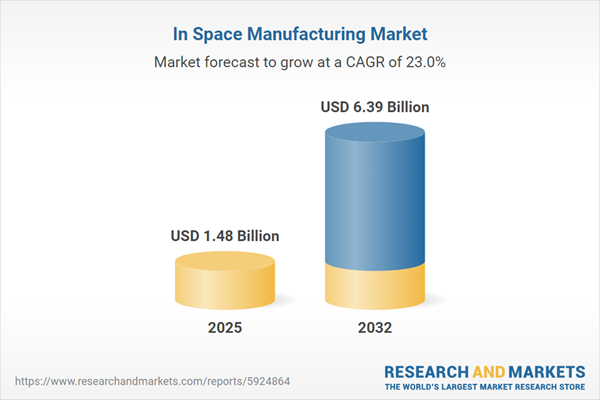Speak directly to the analyst to clarify any post sales queries you may have.
The In Space Manufacturing Market is rapidly transforming the global production landscape, enabling fabrication and assembly in microgravity environments. As commercial, governmental, and research sectors invest in building the next generation of space infrastructure, decision-makers must understand the pivotal factors shaping this dynamic market.
Market Snapshot: In Space Manufacturing Market
The In Space Manufacturing Market grew from USD 1.21 billion in 2024 to USD 1.48 billion in 2025. It is expected to continue growing at a CAGR of 23.04%, reaching USD 6.39 billion by 2032. Fundamental drivers include technological advancements in 3D printing, robotics automation, and microgravity material processing, alongside an increasing flow of private capital and public-private partnerships. These trends are accelerating the scale-up of in-orbit manufacturing, creating new pathways for infrastructure deployment that benefit satellite constellations, lunar operations, and deep space exploration.
Scope & Segmentation Overview
- Technology: 3D Printing (Additive Manufacturing), In-Orbit Assembly Techniques, Microgravity Casting, Molecular Beam Epitaxy, Robotics Automation, Vapor Deposition Techniques
- Materials: Biomaterials, Ceramics, Composites, Metals, Polymers
- Platform: Deep Space Platforms, Orbital Platforms, Space Stations
- Application: Automotive Component Manufacturing, Communication Satellites, Healthcare & Biotechnology (Biologics, Disease Modeling & 3D Bioprinting, Medical Devices & Implants, Regenerative Medicine), Materials Science, Optical Fibers, Semiconductors Fabrication & Assembly
- End Use: Commercial, Government, Research Institutes
- Regional Coverage: Americas (United States, Canada, Mexico, Brazil, Argentina, Chile, Colombia, Peru), Europe, Middle East & Africa (United Kingdom, Germany, France, Russia, Italy, Spain, Netherlands, Sweden, Poland, Switzerland, United Arab Emirates, Saudi Arabia, Qatar, Turkey, Israel, South Africa, Nigeria, Egypt, Kenya), Asia-Pacific (China, India, Japan, Australia, South Korea, Indonesia, Thailand, Malaysia, Singapore, Taiwan)
- Company Profiling: Airbus SE, Anisoprint SARL, ARKA Group LP, Astroscale Holdings Inc., Axiom Space Inc., Dcubed GmbH, Lockheed Martin Corporation, Lunar Resources Inc., Maxar Technologies Holdings Inc., Momentus Inc., Northrop Grumman Corporation, Orbital Composites Inc., Redwire Corporation, Rocket Lab USA Inc., Sierra Nevada Corporation, Space Exploration Technologies Corp., Space Forge Inc., Space Tango LLC, Thales Group, Varda Space Industries Inc., Virgin Galactic Holdings Inc., Voyager Technologies Inc.
Key Takeaways for Decision-Makers
- Microgravity manufacturing unlocks superior material properties, driving adoption in optical fiber, semiconductor, and advanced composite production, while optimizing supply chains for demanding applications.
- Commercialization is accelerating as additive manufacturing, robotics, and resource utilization technologies transition from pilot projects aboard platforms to operational-scale deployment, supporting both space and terrestrial supply chains.
- Regional markets display distinct advantages: the Americas’ advanced aerospace ecosystem promotes quick commercialization; Europe, Middle East & Africa focus on consensus-based standards; and Asia-Pacific leverages national research programs and expanding orbital infrastructure.
- Collaboration models—public-private partnerships, academic alliances, and cross-industry ventures—are enabling scalable innovation and speeding technology transfer from laboratory to operational environment.
- Healthcare and biotechnology segments are rapidly embracing in-space platforms for next-level biologics, regenerative medicine, and 3D bioprinting research, creating new business pathways and partnership opportunities.
- Adaptive supply chain strategies are critical as evolving trade policies and tariff barriers steer investment toward local production capabilities and novel feedstock solutions compatible with orbital conditions.
Tariff Impact: Navigating Supply Chain and Policy Dynamics
New U.S. tariffs introduced in 2025 have changed the sourcing landscape for advanced materials, such as polymers and high-purity metals. The resulting cost increases are prompting manufacturers to pivot toward vertical integration, regional stockpiling, and development of alternative supply options suited to in-orbit processing. Stakeholders are engaged in diplomatic efforts to secure exemptions for space applications, reflecting the market’s strategic importance. Meanwhile, investments in closed-loop recycling and domestic production facilities are strengthening resiliency across the supply chain.
Methodology & Data Sources
This market analysis employs a mixed-method approach, featuring in-depth interviews with executives, review of technical publications, patent analysis, and conference proceedings. Insights are validated through data triangulation, supporting robust and actionable conclusions relevant for market leaders and strategic planners.
Why This Report Matters
- Enables organizations to benchmark technology and material trends, helping senior stakeholders align strategic investments with emerging opportunities in the in-space manufacturing market.
- Delivers regionally nuanced intelligence, guiding go-to-market approaches and partnership models based on local policy, funding, and ecosystem strengths.
- Equips leaders with actionable insights for resilient supply chain design and workforce development tailored for evolving tariff and regulatory conditions.
Conclusion
The in-space manufacturing sector is reshaping industry trajectories worldwide through rapid technology commercialization and adaptive regional strategies. Senior leaders who act with agility and forge focused partnerships can harness its innovation potential and operational advantages.
Additional Product Information:
- Purchase of this report includes 1 year online access with quarterly updates.
- This report can be updated on request. Please contact our Customer Experience team using the Ask a Question widget on our website.
Table of Contents
3. Executive Summary
4. Market Overview
7. Cumulative Impact of Artificial Intelligence 2025
Companies Mentioned
The companies profiled in this In Space Manufacturing market report include:- Airbus SE
- Anisoprint SARL
- ARKA Group, LP
- Astroscale Holdings Inc.
- Axiom Space, Inc.
- Dcubed GmbH
- Lockheed Martin Corporation
- Lunar Resources, Inc.
- Maxar Technologies Holdings Inc.
- Momentus Inc.
- Northrop Grumman Corporation
- Orbital Composites Inc.
- Redwire Corporation
- Rocket Lab USA, Inc.
- Sierra Nevada Corporation
- Space Exploration Technologies Corp.
- Space Forge Inc.
- Space Tango LLC
- Thales Group
- Varda Space Industries, Inc.
- Virgin Galactic Holdings, Inc.
- Voyager Technologies, Inc.
Table Information
| Report Attribute | Details |
|---|---|
| No. of Pages | 198 |
| Published | November 2025 |
| Forecast Period | 2025 - 2032 |
| Estimated Market Value ( USD | $ 1.48 Billion |
| Forecasted Market Value ( USD | $ 6.39 Billion |
| Compound Annual Growth Rate | 23.0% |
| Regions Covered | Global |
| No. of Companies Mentioned | 23 |









